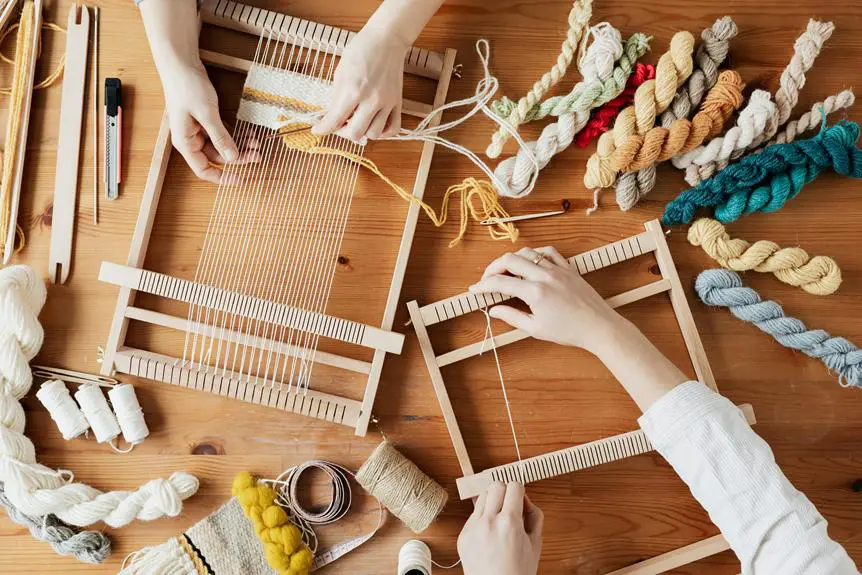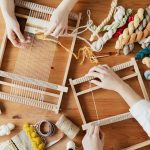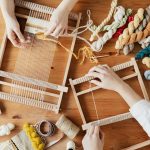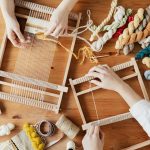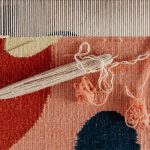If you want to master the art of weaving on your table top loom, you know that the right fabric can make all the difference. From the timeless versatility of cotton to the luxurious drape of silk, your choices matter.
In this guide, we'll explore 8 must-have fabrics that will elevate your weaving projects to new heights. Each fabric offers unique textures, strengths, and characteristics that will expand your mastery of the craft. Whether you're aiming for durability, sheen, or softness, these fabrics are essential for any weaver seeking to create exquisite and diverse textiles.
Let's delve into the world of weaving and discover the perfect fabrics for your table top loom.
Key Takeaways
- Cotton, linen, silk, wool, bamboo, Tencel, hemp, and chenille are versatile fabric options for table top loom weaving.
- Each fabric has unique properties and benefits for different projects, such as durability, softness, strength, and luster.
- Tencel is a sustainable and versatile choice, made from sustainably sourced wood pulp using a closed-loop process.
- Hemp offers durability and strength, with a natural texture showcased in twill or plain weave patterns. Chenille provides a luxurious texture and vibrant color options, perfect for cozy home textiles.
Cotton
When using a table top loom, prioritize the versatility and durability of cotton as an essential fabric. Cotton yarn is a staple for weavers due to its strength and absorbency, making it suitable for a wide range of weaving techniques. Whether you're creating intricate patterns or simple designs, cotton yarn provides a smooth and consistent texture that enhances the overall quality of your woven pieces.
Incorporating cotton yarn into your weaving projects allows you to explore various weaving techniques such as plain weave, twill, and herringbone, showcasing the fabric's adaptability to different patterns and structures. Its ability to hold its shape well and withstand tension makes it an ideal choice for both warp and weft threads, resulting in beautifully crafted textiles with excellent drape and durability.
Furthermore, cotton's natural breathability and softness make it a comfortable choice for creating wearable textiles such as scarves, shawls, and garments. Its color retention properties also ensure that your woven creations maintain their vibrant hues over time, adding to the allure of cotton as a go-to fabric for table top loom weaving projects.
Linen
As you transition from working with cotton to exploring linen, you'll appreciate the distinct qualities this fabric brings to your table top loom weaving projects. Linen, known for its strength and lustrous sheen, adds an elegant touch to your creations. Here are some tips to master linen weaving techniques:
- Embrace the natural texture: Linen's irregularities add character to your woven pieces, creating a unique and organic feel.
- Experiment with open weaves: Linen's long, smooth fibers are perfect for creating airy, breathable fabrics, ideal for table linens and light, summery scarves.
- Pay attention to tension: Linen can be less forgiving than cotton, so maintaining consistent tension is crucial for achieving a balanced weave.
When it comes to caring for your linen creations, keep these fabric care instructions in mind:
- Hand wash or use a gentle machine cycle with mild detergent to preserve the fabric's integrity.
- Avoid wringing or twisting linen, instead gently roll it in a towel to remove excess water before air drying.
- Iron while slightly damp for a crisp, smooth finish.
Mastering linen weaving techniques and understanding proper linen fabric care will elevate your table top loom projects to the next level.
Silk
Explore the versatility of silk as a luxurious fabric for your table top loom weaving projects. Silk is renowned for its lustrous sheen, soft texture, and exquisite drape, making it a prized choice for creating elegant table linens.
The benefits of using silk in your weaving projects include its natural strength, vibrant color absorption, and its ability to regulate temperature. However, silk does have some drawbacks, such as its high cost and its delicate nature, requiring careful handling and cleaning.
When weaving with silk, consider using techniques like plain weave, twill, or satin weaves to showcase the fabric's natural beauty. Experiment with incorporating different silk yarn weights and textures to add depth and visual interest to your designs. Additionally, explore patterns such as houndstooth, herringbone, or damask for a sophisticated touch to your table linens.
To fully harness the potential of silk, it's crucial to understand its unique properties and characteristics. By mastering silk weaving techniques and patterns, you can elevate your table top loom projects, creating stunning and luxurious table linens that are sure to impress.
Wool
Silk's luxurious qualities make it a prized choice for table top loom weaving, and wool offers its own unique benefits for your projects. Wool is a versatile and durable fabric that's perfect for creating a variety of woven items. Here's why you should consider incorporating wool into your table top loom projects:
- Warm and Insulating: Wool is an excellent choice for creating cozy and warm textiles. Its natural insulating properties make it ideal for weaving items like blankets, scarves, and shawls that provide exceptional warmth during cooler seasons.
- Versatile and Durable: Wool is a highly versatile fabric that can be used to create a wide range of woven products. From durable rugs to stylish garments, wool can withstand regular use and maintain its quality over time, making it a lasting choice for your table top loom projects.
When it comes to weaving, wool's warmth, insulating qualities, versatility, and durability make it a must-have fabric for your table top loom. Incorporating wool into your projects will allow you to create beautiful, functional, and long-lasting woven items.
Bamboo
Looking for a fabric that's eco-friendly, durable, soft, and breathable for your table top loom? Then bamboo is the perfect choice for your weaving projects.
Not only is bamboo fabric sustainable and biodegradable, but it also has natural antibacterial properties, making it a great option for creating table linens and other textiles.
Its softness and breathability will ensure that your woven creations aren't only beautiful but also practical for everyday use.
Eco-Friendly and Durable
When weaving on a table top loom, you'll find that bamboo is an eco-friendly and durable fabric option to consider. Bamboo fabric is made from sustainable materials, making it an excellent choice for environmentally conscious weavers.
Additionally, bamboo fibers are known for their long-lasting qualities, ensuring that your woven creations will stand the test of time. This fabric also possesses excellent moisture-wicking properties, keeping your table linens fresh and dry.
Furthermore, bamboo's natural antibacterial and hypoallergenic properties make it a great option for those with sensitive skin. Embracing bamboo fabric for your table top loom projects not only contributes to sustainable practices but also ensures durable and high-quality results for your weaving endeavors.
Soft and Breathable
For your table top loom projects, bamboo fabric offers a soft and breathable option that complements its eco-friendly and durable qualities.
Bamboo is a natural fiber that provides comfortable wear, making it an excellent choice for creating textiles on your loom. Its breathability makes it ideal for creating items like scarves, shawls, and lightweight blankets.
Bamboo fabric is easy to care for and offers long-lasting performance, ensuring that your woven creations will stand the test of time. When working with bamboo on your loom, you'll appreciate its smooth texture and drape, allowing you to create elegant and luxurious pieces.
Incorporating bamboo into your weaving projects not only adds a touch of sophistication but also contributes to sustainable and environmentally friendly practices.
Tencel
You'll love working with Tencel as it's a sustainable and versatile choice for your table top loom.
Its soft and smooth texture makes it a pleasure to weave with, and it's an ideal option for weft yarn in your projects.
Tencel's eco-friendly properties and luxurious feel make it a must-have fabric for your weaving endeavors.
Sustainable and Versatile Choice
Choosing Tencel as a sustainable and versatile fabric for your table top loom offers numerous benefits and possibilities.
Tencel is environmentally friendly, made from sustainably sourced wood pulp, and produced using a closed-loop process that minimizes environmental impact.
It's also cost-effective, as it's durable and long-lasting, reducing the need for frequent replacement.
Tencel is versatile, suitable for creating a wide range of projects on your loom, from soft and breathable garments to sturdy and absorbent household textiles.
Additionally, it's low maintenance, requiring minimal care and washing easily.
With its smooth and lustrous finish, Tencel is a perfect choice for weavers who seek a sustainable, adaptable, and easy-to-care-for fabric for their creations.
Soft and Smooth Texture
Achieving a soft and smooth texture with Tencel on your table top loom is attainable with proper weaving techniques and attention to tension. Tencel, a natural fiber known for its luxurious drape and silky feel, is a fantastic choice for creating elegant and lustrous fabrics. Its textile properties make it an ideal material for producing garments, linens, and decorative items. When woven with care, Tencel yields a fabric that is not only visually appealing but also incredibly soft to the touch. The table below outlines some key textile properties of Tencel:
| Property | Description |
|---|---|
| Softness | Luxuriously smooth |
| Drape | Elegant and flowing |
| Breathability | Comfortably airy |
| Strength | Resilient and durable |
| Luster | Subtle sheen |
Mastering the art of weaving with Tencel can enhance your craftsmanship, elevating the quality of your woven creations.
Ideal for Weft Yarn
To achieve optimal results in weaving with Tencel as your weft yarn on a table top loom, proper tension and weaving techniques are crucial.
Tencel, a luxurious and versatile fiber, offers an array of benefits when used as weft yarn. Its smooth and lustrous nature allows for the creation of colorful patterns and texture variety, elevating the overall look and feel of your woven fabric.
When combined with other fibers, Tencel adds a beautiful sheen and drape to the fabric, enhancing the visual appeal of your woven designs. Additionally, Tencel's excellent color retention properties make it an ideal choice for creating vibrant and long-lasting woven pieces.
Experiment with Tencel as your weft yarn to unlock a world of weaving possibilities.
Hemp
You can frequently find hemp yarn or fabric at specialty shops and online retailers, making it a versatile and accessible material for your table top loom projects. Hemp yarn is known for its durability and strength, making it an excellent choice for weaving techniques that require sturdy and long-lasting fabric. When using hemp yarn for your table top loom projects, consider incorporating twill or plain weave patterns to showcase the natural texture and strength of the yarn. Experiment with different setts and weaving structures to achieve varying levels of drape and density in the finished fabric.
In addition to hemp yarn, hemp fabric is also a popular choice for table top loom weaving. Hemp fabric can be dyed using a variety of methods, including natural dyeing techniques with plant-based dyes or synthetic dyeing for a more vibrant and uniform color. Due to its absorbent nature, hemp fabric takes dyes well, allowing you to explore a wide range of color possibilities for your table top loom projects. Whether you prefer natural earthy tones or bold, saturated hues, hemp fabric offers versatility in creating visually striking woven pieces.
Chenille
When weaving with a table top loom, consider incorporating chenille yarn for its luxurious texture and vibrant color options, expanding your creative possibilities beyond the durability of hemp. Chenille weaving techniques offer a unique tactile experience, creating soft, velvety fabric that's perfect for cozy home textiles. This yarn is ideal for crafting plush blankets, sumptuous scarves, and elegant upholstery.
To fully explore the potential of chenille, it's essential to select the right yarn sources and color options. Look for reputable suppliers who offer a wide range of chenille yarn in various hues, from rich jewel tones to soft pastels. The color options available in chenille yarn allow you to bring your creative visions to life with unmatched vibrancy and depth.
To unleash your creativity with chenille, try weaving a statement throw with intricate patterns, experimenting with textural elements for a tactile masterpiece, or crafting luxurious pillows that add a touch of opulence to any space. With its sumptuous feel and versatile nature, chenille yarn opens up a world of creative projects for your table top loom.
Frequently Asked Questions
Are There Any Specific Care Instructions for Maintaining the Quality of These Fabrics on a Table Top Loom?
To maintain fabric quality on a table top loom, follow care instructions for the specific material. Consider the dyeing process and its effects on the fabric. Regular maintenance ensures longevity and optimal performance.
Can These Fabrics Be Easily Dyed or Does the Material Affect the Dyeing Process?
Fabric dyeing can be affected by the material. Some fabrics are more receptive to dye than others. Consider fabric properties and the dyeing process when choosing materials for your table top loom.
What Are Some Common Weaving Patterns or Techniques That Work Well With Each of These Fabrics?
When weaving with different fabrics on your table top loom, it's essential to understand common weaving patterns and suitable techniques for each material. Experiment with color combinations and design possibilities to find the best materials for your projects.
Are There Any Sustainability or Ethical Considerations to Keep in Mind When Working With These Fabrics on a Table Top Loom?
When working with fabrics on your table top loom, it's essential to consider sustainability and ethical sourcing. Look for materials with minimal environmental impact and support fair trade practices to ensure ethical considerations are met.
How Does the Weight and Texture of Each Fabric Affect the Final Product When Woven on a Table Top Loom?
When weaving on a table top loom, consider how the weight and texture of each fabric affect the final product. Adjust tension control for different fabrics and weaving patterns. Experiment with color blending and yarn selection to achieve desired results.
- Can You Get Organza Wet? - April 23, 2024
- Why Is Organza so Popular? - April 23, 2024
- What Do You Wear With Organza? - April 23, 2024

